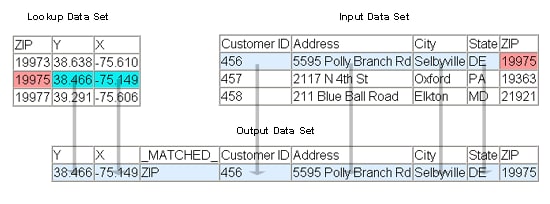GEOCODE Procedure
Understanding Output Data
How Geocoded Data Is Produced
When the GEOCODE procedure
finds a match in the lookup data set, the procedure adds the associated
coordinates to the observation in the output data set. Longitude is
stored as the X variable, and latitude is stored as the Y variable.
The following image shows how the GEOCODE procedure
obtains coordinates for the output data set by matching the ZIP code
in the input data set:
The GEOCODE procedure also adds
a variable named _MATCHED_ that indicates how the coordinates were
found. Possible values for the _MATCHED_ variable are as follows:
A match was found for
either the street address and ZIP code or the street address, city,
and state.
Multiple observations
in the lookup data set specified with the PLUS4 geocoding method matched
the five-digit ZIP code and the matching latitude and longitude coordinate
values were averaged.
Multiple observations
in the SASHELP.ZIPCODE or user-supplied lookup data set matched the
city and state. In either case, the matching latitude and longitude
coordinate values were averaged.
For each observation in the input data set, the GEOCODE
procedure attempts to match the address variable value to a value
in the lookup data set. For most geocoding methods, the lookup data
set is expected to contain only one matching observation. For example,
the SASHELP.ZIPCODE data set contains only one observation for each
ZIP code. If the lookup data set contains multiple matches, then the
first matching observation is returned, except as noted in the following
paragraph.
Some geocoding methods process multiple
matches. For example, if you are using ZIP code geocoding and no match
is found, then the GEOCODE procedure attempts to find a matching city-and-state
pair. The SASHELP.ZIPCODE data set contains multiple observations
for many city-and-state pairs. When a ZIP code is not found in this
lookup data set, the GEOCODE procedure searches for a matching city-and-state
pair. If one match is found, then the coordinates for the matching
pair are used. When the GEOCODE procedure uses either the STREETor
PLUS4 geocoding method and no match is found for the combined ZIP
code and ZIP+4 values, it then searches for the five-digit ZIP code
only.
Output Data Sets
By default, the GEOCODE
procedure produces an output data set that contains all of the variables
from the input address data set and the X, Y, and _MATCHED_ variables.
The X and Y coordinates use the same system as the lookup data set.
The lookup data coordinate system is typically based on world latitudes
and longitudes, but X-Y values in a specific map projection can also
be used. If you want to use a different coordinate system for the
output, you can convert the geocoded coordinates using a projection
system application such as the GPROJECT procedure.
The default name for
the output data set is DATAn,
where n is the smallest integer
that makes the name unique. For example, if the DATA1 data set already
exists, then the default name for the output data set is DATA2.
The label of the output
data set contains the text, "Geocoded date"
where date is the date when
the output was created. This text is appended to the label from the
input data set, if one exists.
For the STREET geocoding
method, additional variables are included in the output data set. See Output Variables for Street Geocoding..
Adding Variables to the Output Data Set
You can specify that
non-geocoding variables from the lookup data set be added to the output
data set by using the ATTRIBUTEVAR= option in the PROC GEOCODE statement.
For example, if you are using SASHELP.ZIPCODE as the lookup data set,
then you could assign the county name (COUNTYNM) to each matched observation
in the output data set.

